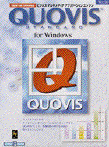Pro gramming Without Writing Code

If you're a nonprogrammer but want to program using visual data, develop
visual front ends to database files, or quic
kly produce high-quality multimedia
solutions, Digital Cell Technology and its commercial implementation, Quovis,
may be your ticket to success.
by Steven Myers
Quovis, the multimedia application development tool from Sofmap
F Design,
has quickly become one of the most talked-about software products in the
Japanese computer industry. In line with recent movements toward object/component-
and visual-based programming paradigms, the Quovis application development
environment c
omprises a set of mini-applications, or "cells,"
that are customized and linked together by a programmer to produce a larger
application. Each cell is optimized to perform a particular function --
such as displaying visual files, creating button
s, or playing videos. By
filling out dialog boxes to customize the cells, users can quickly create
applications involving the presentation and interpretation of visual data
(maps, photos, or videos) without having to write any code.
The technolo
gy behind Quovis was conceived and developed by a diverse, synergistic
trio called F Design. Wataru Shoji, chief "visionary" and spokesman
for the group, joined forces with hardware engineer Daisuke Tabuchi and
programmer Ichiro Nakajima to crea
te the "cell-oriented" application
development approach. The team, which dubbed its new concept "Digital
Cell Technology," merged with Akihabara-based Sofmap in March 1995
to create a new company, Sofmap F Design. Sofmap F Design is de
voted to
the production and marketing of Quovis. It currently employs about 30 people,
and has so far released Japanese versions of Quovis Standard 1.0 (a set
of 12 cells for professional developers) and Quovis Personal (a lower priced
package for home/in
dividual use, containing only the three main cells).
Work is underway on an English version of Quovis, which is expected to be
ready for release sometime this year.
Because the Quovis development environment is so intuitive, even non-programmers
can create sophisticated multimedia applications that would require significantly
more effort using such popular programming languages as Visual Basic or
C++. For one thing, no compilation is required when using Quovis; each cell
is a fully debugged, exe
cutable application in-and-of itself. The developer
adds new features to his/her application simply by refining the appropriate
cell. These features can then be used and tested immediately. Likewise,
applications can be modified on-the-fly simply by click
ing on a cell and
changing the parameters in its dialog box.
The benefits of developing multimedia applications under Quovis are clear:
quicker development, lower costs, and simplification of application maintenance.
On the down side, however, t
here are limits to the degree of customization
that can be achieved with any one cell, and as with most visual-based programming
tools, there often are times when the user wants to control the function
of a program at a level of detail not yet supported b
y the development environment.
Still, the tool is excellent for prototyping and presentations, and as more
cells are made available by Sofmap F Design, the level of control over application
features should increase accordingly.
A usable tool
If
your programming work calls for the handling of visual data, Quovis is
certainly worth a look. All of the cells making up the development environment
are optimized for displaying visual files, a feature most noticeable when
scrolling large maps. (Quovis
allows "superscrolling" in any direction
without having to use scroll bars or wait for screen redraws.) Response
is instantaneous, even for 1GB raster files, and the environment is extremely
simple to learn and use.
Quovis can also be
used to develop visual front ends to database files created
in major relational databases, including Oracle, Sybase, and Informix. The
visual interface is created using Quovis, and the resulting program can
be linked to the database using a routine writte
n in a high-level language
such as C++.
For producing high-quality multimedia solutions in a minimum of time, the
advantages of Quovis far outweigh the limitations. The program enables artists
and graphic designers to take over jobs that previou
sly required the assistance
of professional programmers.
We've barely scratched the surface with this introductory look. Watch for
more about this unique development tool, and the details of Digital Cell
Technology, in an upcoming
issue of <
I>Computing Japan.ç
Quovis
Typical applications:
Geographic Information Systems (GIS)/mapping
Scientific visualization
Blueprint management
Basic multimedia
Document manageme
nt
Supported File Types:
Vector graphics (.dxf, .dvg)
Raster graphics (.bmp, .tif)
Animation (.avi)
Sound (.wav, .mid)
Text (.wri, .txt)
System Requirements:
IBM-compatible PC
with 386 or higher CPU
Microsoft Windows 3.1 or higher
14" or larger display
8MB RAM
170MB available space on hard disk
Mouse
For more information about Digital Cell Technology and Quovi
s, contact:
Sofmap F Design
Kitazawa Bldg.
3-14-9 Soto-Kanda
Chiyoda-ku, Tokyo 101
Japan
Phone +81-3-3251-3015
Fax +81-3-3253-4228
Sofmap F Design USA, Inc.
1111 Bay
hill Drive, Suite 435
San Bruno, CA 94066
USA
Phone +1-415-827-7300
Fax +1-415-827-7301
(c) Copyright 1996 by Computing Japan magazine
